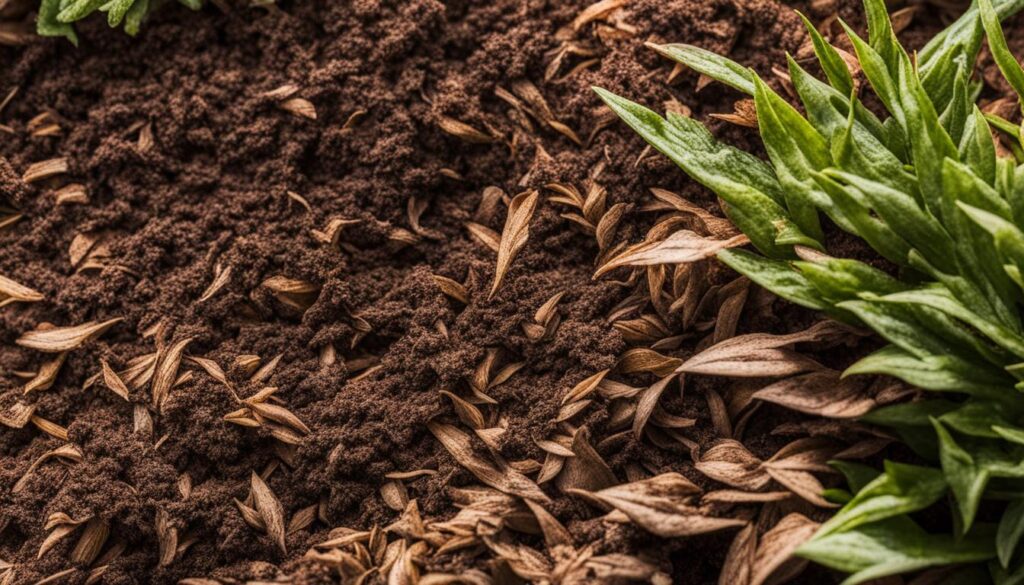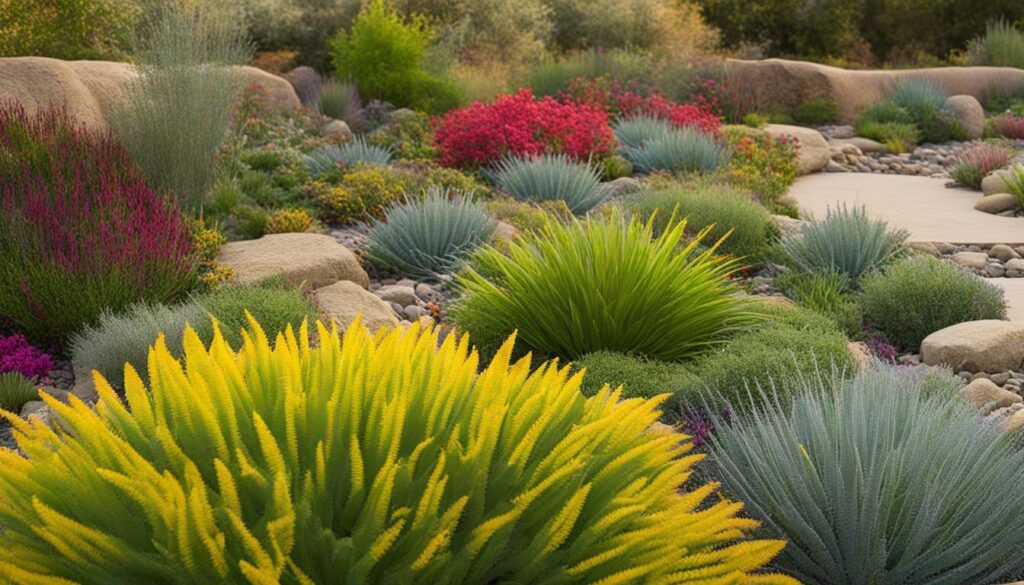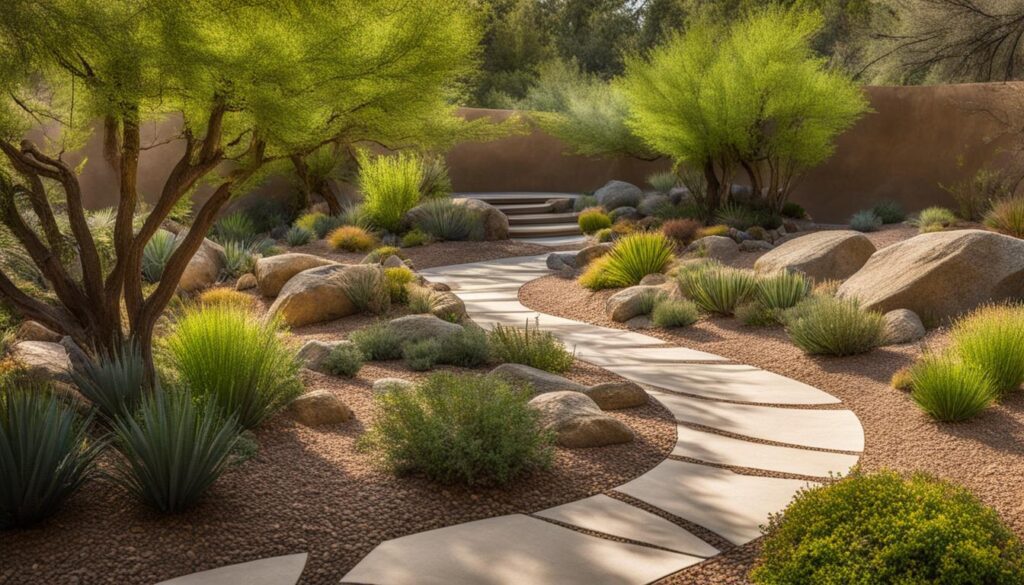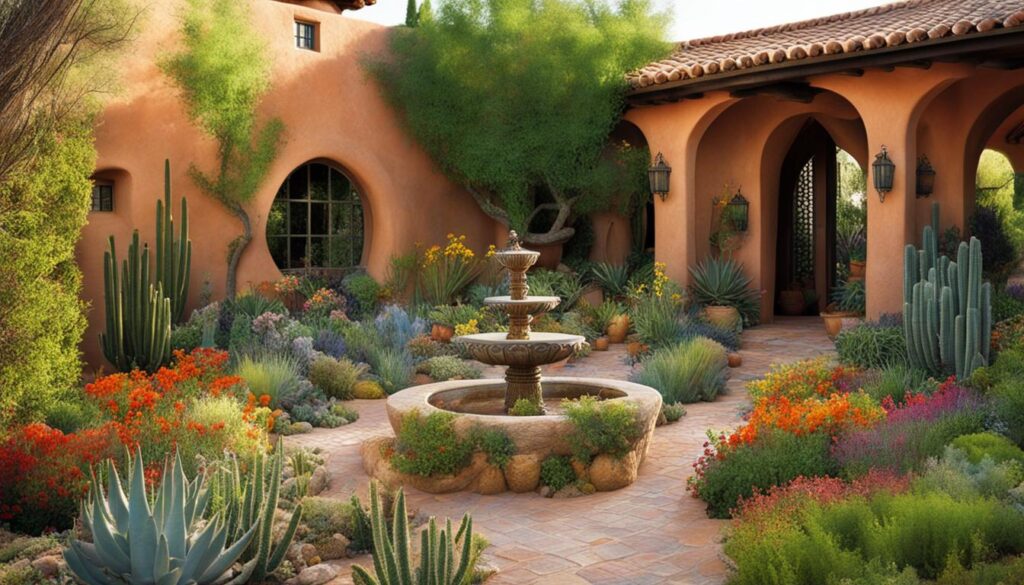Xeriscaping is a water-wise landscaping approach that can help create beautiful and low-maintenance landscapes in dry environments. By using native plants, mulch, rocks, and drip irrigation systems, public parks can conserve water while still maintaining an attractive and engaging aesthetic. This article explores various innovative xeriscaping ideas that can be implemented in public parks to promote sustainability and beauty.
Key Takeaways:
- Implementing xeriscaping in public parks can help conserve water and reduce maintenance.
- Consider using mulch as it improves soil fertility, limits weed growth, and enhances the overall appearance of the landscape.
- Incorporate low-maintenance groundcovers and drought-tolerant grasses to reduce water usage and maintenance.
- Create functional garden paths using permeable materials to promote water absorption and eco-friendliness.
- Add rock gardens to prevent evaporation and create visually appealing focal points.
The Role of Mulch in Xeriscaping Designs
Mulch plays a crucial role in xeriscaping designs, offering numerous benefits that contribute to the overall success of a water-wise landscaping approach. By layering the soil with a protective covering, mulch helps conserve water, improve soil fertility, and enhance the aesthetic appeal of the landscape.
There are several types of mulch that can be used in xeriscaping, each with its own unique characteristics and benefits. Pine bark mulch, for example, not only helps retain moisture but also adds a natural and rustic look to the garden. Crushed stones, on the other hand, provide excellent drainage and can give a more contemporary feel to the landscape. Shredded bark mulch is another popular option as it offers a neat and uniform appearance while retaining moisture and suppressing weed growth.
There are numerous benefits of using mulch in xeriscaping designs. Mulch acts as a protective layer that minimizes evaporation, reducing water loss from the soil surface. It also helps regulate soil temperature, keeping it cooler in hot weather and warmer in cold weather. In addition, mulch inhibits weed germination and growth by creating a barrier that prevents sunlight from reaching weed seeds. This reduces the need for manual weeding and saves both time and effort. Lastly, mulch adds visual appeal to the landscape, providing a finished and polished look to the overall xeriscaping design.
Types of Mulch:
- Pine bark mulch
- Crushed stones
- Shredded bark mulch
Benefits of Mulch:
- Conserves water
- Improves soil fertility
- Enhances aesthetic appeal
- Reduces evaporation
- Inhibits weed growth
Low-Maintenance Groundcovers for Xeriscape Designs
When it comes to designing public parks with a focus on sustainability and ease of maintenance, incorporating low-maintenance groundcovers is a smart choice. These groundcovers not only require less water but also add visual interest and texture to the xeriscape design. Here are some popular options:
- Creeping Thyme: This low-growing groundcover is known for its fragrant flowers and ability to withstand dry conditions. It spreads quickly and forms a dense mat, effectively suppressing weed growth.
- Lantana: With its vibrant flowers and drought tolerance, lantana is an excellent choice for xeriscape parks. It attracts pollinators and adds a splash of color to the landscape.
- Silver Carpet: This groundcover features silver-gray foliage and delicate yellow flowers. It thrives in full sun and well-drained soil, making it ideal for xeriscape designs.
- Low-Lying Sedum: Sedums, also known as stonecrops, come in a variety of colors and sizes. They are incredibly hardy and require minimal maintenance, making them perfect for low-water landscapes.
By incorporating these low-maintenance groundcovers, you can reduce water usage and the need for frequent maintenance in public parks. Not only do they require less water, but they also provide ground cover, preventing soil erosion and inhibiting weed growth. These groundcovers are a beautiful and sustainable choice for xeriscape designs.
In addition to low-growing groundcovers, consider incorporating drought-tolerant grasses throughout the landscape. Ornamental grasses, such as Fountain Grass and Blue Fescue, add height, movement, and textural contrast to the xeriscape design. These grasses thrive in dry conditions and require minimal watering, making them an excellent choice for low-maintenance landscapes.
Designing Functional Garden Paths in Xeriscape Parks
Garden paths play a crucial role in enhancing the functionality and aesthetics of xeriscape parks. By incorporating eco-friendly pathways, such as permeable pavers, you can create a sustainable and visually appealing environment. Permeable pavers allow rainwater to seep through the gaps, replenishing the soil instead of creating runoff. This promotes better water absorption and reduces the strain on irrigation systems.
Benefits of Eco-Friendly Pathways
- Prevents soil erosion: Eco-friendly pathways help prevent soil erosion by directing rainwater into the ground rather than washing it away.
- Promotes plant growth: By allowing water to reach the soil, permeable pavers support the healthy growth of plants and contribute to the overall health of the xeriscape park.
- Improves water conservation: Traditional paved pathways can lead to significant water waste by causing excess runoff. Eco-friendly pathways help conserve water by retaining it within the park’s ecosystem.
In addition to using permeable pavers, you can also enhance the beauty of garden paths by incorporating natural stones, like bluestone or slate. These stones not only add a visually appealing touch but also create a longer-lasting pathway that can withstand heavy foot traffic.
Overall, designing functional garden paths using eco-friendly materials and natural stones is a sustainable approach that harmonizes with the xeriscape park concept. It allows for efficient water management while enhancing the overall aesthetics of the park. By taking these steps, you can create an inviting and environmentally conscious space that visitors will appreciate.
Incorporating Rock Gardens in Xeriscape Parks
Rock gardens can be a stunning addition to xeriscape parks, bringing both beauty and functionality to the landscape. By strategically arranging boulders and incorporating various types of rocks, you can create visually striking focal points that blend seamlessly with the surrounding environment.
When designing a rock garden, consider using a combination of different-sized boulders to add depth and dimension. Larger boulders can serve as anchor points, while smaller rocks can be placed strategically to create pathways or define planting areas. This arrangement not only adds visual interest but also helps prevent evaporation by shading the soil beneath.
To enhance the overall appeal of your rock garden, consider incorporating cascading ground covers. These low-growing plants can be planted between the rocks to create a beautiful, natural-looking cascade effect. Creeping thyme, lamium, and creeping phlox are excellent choices for ground covers that thrive in xeriscape environments and add vibrant colors and textures to the landscape.
By incorporating rock gardens in xeriscape parks, you can create visually stunning landscapes that require minimal water and maintenance. The natural beauty of rocks and the vibrant colors of cascading ground covers make for a unique and inviting outdoor space that visitors can enjoy while also supporting sustainable water conservation practices.
How Can Xeriscaping Benefit Public Parks in Urban Areas?
Xeriscaping solutions for urban conservation offer numerous benefits to public parks in urban areas. By using drought-resistant plants and efficient irrigation systems, xeriscaping can help conserve water, reduce maintenance costs, and create sustainable green spaces that thrive in urban environments.
Mediterranean-Inspired Xeriscaping Ideas
When it comes to creating a stunning and sustainable xeriscape garden, taking inspiration from the Mediterranean is a great choice. The Mediterranean climate is known for its hot, dry summers and mild, wet winters, making it the perfect environment for drought-hardy herbs and culinary plants. By incorporating these Mediterranean-inspired elements into your xeriscape design, you can create a beautiful and functional landscape that thrives even in limited water conditions.
Drought-hardy herbs like thyme, rosemary, oregano, and lavender are excellent choices for a Mediterranean xeriscape. These plants not only require less water but also offer delightful fragrances and can be used in cooking. Imagine strolling through your xeriscape garden and brushing your hand against a fragrant lavender bush. It’s a sensory experience that can transport you to the sun-soaked regions of the Mediterranean.
“By incorporating Mediterranean herbs into your xeriscape design, you not only create a visually appealing landscape but also have access to fresh herbs for your culinary adventures.”
One way to integrate these herbs is by planting them strategically along garden paths. This allows visitors to enjoy the pleasant scents as they explore the park, immersing themselves in the soothing ambiance of a Mediterranean garden. Additionally, having these herbs readily available means you can step outside and snip fresh sprigs for your favorite recipes, adding a burst of flavor to your culinary creations.
So, if you’re looking to transform your xeriscape garden with a touch of Mediterranean charm, consider incorporating drought-hardy herbs like thyme, rosemary, oregano, and lavender. Not only will these plants thrive in limited water conditions, but they will also provide visual appeal, delightful fragrances, and fresh culinary experiences. Embrace the beauty and sustainability of a Mediterranean-inspired xeriscape garden.
Creating Rain Gardens and Harvesting Rainwater
Rain gardens and rainwater harvesting systems play a crucial role in xeriscaping public parks, promoting sustainable water usage. Rain gardens serve as a means of collecting and storing stormwater, allowing it to percolate into the soil instead of contributing to runoff. By carefully selecting plants that can withstand both dry and wet conditions, rain gardens not only conserve water but also enhance the park’s visual appeal.
Rainwater harvesting systems are another effective method of reducing reliance on potable water sources. These systems redirect runoff from roof-like surfaces and store the collected rainwater for future use in irrigation. By harnessing this natural resource, public parks can significantly decrease their water consumption, contributing to environmental sustainability.
Implementing rain gardens and rainwater harvesting systems not only conserves water but also helps to create a more resilient and eco-friendly park. By integrating these practices into xeriscaping designs, parks can better adapt to fluctuating rainfall patterns and mitigate the impacts of drought. Embracing these innovative solutions is a step towards a more sustainable future for our public parks.














